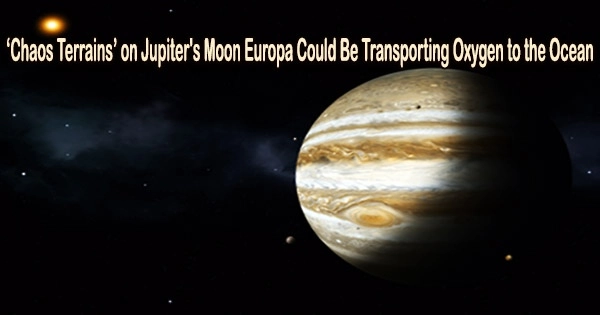According to a team of researchers led by The University of Texas at Austin, salt water within Jupiter’s moon Europa’s icy crust could be delivering oxygen into an ice-covered ocean of liquid water, where it could potentially help sustain extraterrestrial life.
Others have proposed this theory, but the researchers put it to the test by creating the world’s first physics-based computer simulation of the process, with oxygen hitching a ride on salt water beneath the moon’s “chaos terrains,” which cover a quarter of the icy world.
The findings reveal that not only is transfer possible, but that the amount of oxygen delivered into Europa’s ocean might be comparable to the amount of oxygen in Earth’s oceans today.
“Our research puts this process into the realm of the possible,” said lead researcher Marc Hesse, a professor at the UT Jackson School of Geosciences Department of Geological Sciences. “It provides a solution to what is considered one of the outstanding problems of the habitability of the Europa subsurface ocean.”
The study was recently published in the journal Geophysical Research Letters.
Europa is a prime candidate for alien life because scientists have discovered indications of oxygen and water, as well as compounds that could function as nutrition. The moon’s ice shell, which is thought to be roughly 15 miles thick, acts as a barrier between water and oxygen created by sunlight and charged particles from Jupiter striking the frozen surface.
“If life as we know it exists in the ocean, there needs to be a way for oxygen to get to it.” According to Hesse, “the most plausible scenario based on the available evidence is for the oxygen to be carried by salt water, or brine.”
Chaos terrains, according to scientists, arise above locations where Europa’s ice cover partially melts to generate brine, which can mix with oxygen from the surface. The researchers’ computer model demonstrated what happens to the brine once the chaos landscape forms.
We know that Europa has useful compounds like oxygen on its surface, but do those make it down into the ocean below, where life can use them?. In the work by Hesse and his collaborators, the answer seems to be yes.
Kevin Hand
The model depicted the brine draining in a unique way, taking the shape of a “porosity wave” that causes holes in the ice to temporarily enlarge, allowing the brine to travel through before sealing back up. Hesse likens the process to the iconic cartoon comedy of a bulge of water draining from a garden hose.
With 86% of the oxygen taken up at the surface riding the wave all the way to the ocean, this form of conveyance appears to be an effective technique to carry oxygen through the ice. However, the evidence given allows for a wide range of oxygen levels delivered to Europa’s water over its history, with estimates varying by a factor of 10,000.
According to co-author Steven Vance, a research scientist at NASA’s Jet Propulsion Laboratory (JPL) and the supervisor of its Planetary Interiors and Geophysics Group, the highest estimate would make the oxygen levels in Europa’s ocean similar to those in Earth’s oceans which raises hope about the potential for that oxygen to support life in the hidden sea.
“It’s enticing to think of some kind of aerobic organisms living just under the ice,” he said.
Vance said that NASA’s upcoming 2024 Europa Clipper mission may help improve estimates for oxygen and other ingredients for life on the icy moon.
Kevin Hand, a scientist focused on Europa research at NASA JPL who was not part of the study, said that the study presents a compelling explanation for oxygen transport on Europa.
“We know that Europa has useful compounds like oxygen on its surface, but do those make it down into the ocean below, where life can use them?” he said. “In the work by Hesse and his collaborators, the answer seems to be yes.”
NASA, the National Science Foundation and the American Chemical Society Petroleum Research Fund funded the research.
In addition to the Jackson School, Hesse is also a researcher at the UT Center for Planetary Systems Habitability and the Oden Institute for Computational Engineering and Sciences.
















